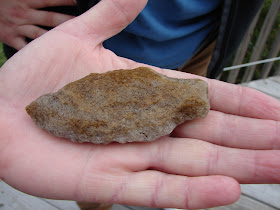by Roberta Estes
On Tuesday evening, Andy Powell and I were honored to speak at the Hatteras Island Genealogical and Preservation Society in Avon. The evening began with a lovely pot luck carry in provided by the members of the society. The main courses were provided by HIGS and the Lost Colony Research Group. Side dishes were brought by attendees. These meals are always the best.
Someone brought a wonderful Hatteras Island clam chowder, an island specialty. W what a treat! There is just nothing like local specialties. I can envision this same clam chowder nourishing the ancestors of these folks, who may indeed have been the Lost Colonists.
Anne Poole, Research Director for the Lost Colonists began the evening with a brief introduction and then the first speaker, yours truly, spoke about the Lost Colony, the DNA project, the Hatteras Families projects, and the historical and genealogical projects we’ve undertaken in an effort to find the colonists. Given what the colonists themselves told us about where they were going, it seems that Hatteras Island is the best place to look for them, and where we are most likely to find them. I couldn’t help but wonder if I wasn’t looking at the colonists’ descendants as I was speaking about the project.
Anne Poole then spoke again about the various surnames involved with the Lost Colony and her efforts to work with the families who carry those surnames in eastern NC.
Andy Powell, the retiring mayor of Bideford, England, the port from whence the colonists sailed, and possibly the home of some of them, spoke next. Andy’s book, Sir Richard Grenville and the Lost Colony of Roanoke was recently released. In fact, so recently, that Andy wasn’t sure he could even get books here for the event. Thankfully, he had a least a few to sign for people.
Andy re-translated the original documents, and in his book, he then provides the original translation in addition to “understanding aids” for us. To say there is a bit of a language barrier would be an understatement, but his translations from early English to contemporary English make the difference between slogging through a book and a ‘good read’. This book is both fascinating in its history, but also simply as a good book. Few books achieve both.
Something I found even more remarkable is that Andy truly knows his topic inside and out and upside down. He has all of these facts in his head. He used no notes or Powerpoint, but talked directly about the history, including exact dates, as he wrote in his book. Not only is he the most authoritative voice on Grenville worldwide, but he loves the topic of the Lost Colony mystery and history, and hopes that the interest in the Lost Colony will provide both the NC coastal communities as well as Bideford some rejuvenation to their economy.
Indeed it may, as exchanges are already underway. Later this week, the Bideford marching band will be performing in Manteo! Bideford and Manteo are twinned, with the official ceremony taking place in 2010.
After the speakers, questions were taken from the audience and many people visited with the speakers as well as others from both groups. Many who attended were members of HIGS, but Dawn Taylor, HIGS founder, mentioned that she saw several new faces.
The LCRG and HIGS are collaborating to create the Hatteras Families genealogy data base, and several people used that resource to look up ancestors. This data base is the underlying foundation of the Hatteras Families DNA projects. Ultimately, Dawn hopes to add detail for each of the early island families.
Andy Powell, Anne Poole and I, in addition to our other LCRG members who were present, would like to thank Dawn Taylor and the rest of the HIGS folks who worked hard on preparations to have a lovely evening for their hospitality.






























